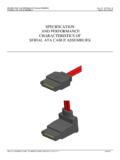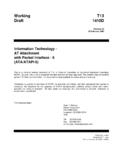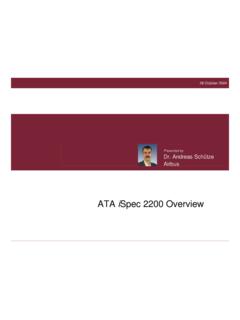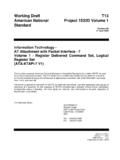Transcription of 2000 MY OBD-II System Operation Summary
1 FORD MOTOR COMPANY REVISION DATE: SEPTEMBER 14, 2001 PAGE 1 OF 57 2000 MY OBD System Operation Summary for Gasoline Engines Table of Contents Introduction OBD-I and 3 Catalyst Efficiency 4 Misfire 6 AIR System Monitor .. 10 EVAP System Monitor - dia. leak check .. 11 EVAP System Monitor - dia. leak check .. 14 Fuel System Monitor .. 21 HO2S Monitor .. 22 DPFE EGR System Monitor .. 26 PCV System Monitor .. 31 Thermostat Monitor .. 31 Comprehensive Component Monitor - Engine .. 32 Comprehensive Component Monitor - Transmission .. 37 FORD MOTOR COMPANY REVISION DATE: SEPTEMBER 14, 2001 PAGE 2 OF 57 4R70W (RWD) Transmission .. 44 AX4S/AX4N (FWD) Transmission .. 45 CD4E (FWD) Transmission .. 46 4R44E (RWD) Transmission .. 47 5R55E (RWD) Transmission .. 48 5R55N (RWD) Transmission .. 49 4R100 (E4OD) (RWD) 51 4F27E (FN) (FWD) Transmission .. 52 On Board Diagnostic 53 Exponentially Weighted Moving Average.
2 54 I/M Readiness 56 Catalyst Temperature Model .. 57 Serial Data Link MIL Illumination .. 57 FORD MOTOR COMPANY REVISION DATE: SEPTEMBER 14, 2001 PAGE 3 OF 57 Introduction OBD-I and OBD-II OBD-II Systems California OBD-II applies to all gasoline engine vehicles up to 14,000 lbs. Gross Vehicle Weight Rating (GVWR) starting in the 1996 MY and all diesel engine vehicles up to 14,000 lbs. GVWR starting in the 1997 MY. "Green States" are states in the Northeast that chose to adopt California emission regulations, starting in the 1998 MY. At this time, Massachusetts, New York, Vermont and Maine are Green States. Green States receive California-certified vehicles for passenger cars and light trucks up to 6,000 lbs. GVWR. The National LEV program (NLEV) requires compliance with California OBD-II , including " evaporative System monitoring requirements. The NLEV program apply to passenger cars and light trucks up to 6,000 lbs.
3 GVWR nation-wide from 2001 MY through 2003 MY Federal OBD applies to all gasoline engine vehicles up to 8,500 lbs. GVWR starting in the 1996 MY and all diesel engine vehicles up to 8,500 lbs. GVWR starting in the 1997 MY. OBD-II System implementation and Operation is described in the remainder of this document. OBD-I Systems If a vehicle is not required to comply with OBD-II requirements, it utilizes an OBD-I System . OBD-I systems are used on all over 8,500 lbs. GVWR Federal truck calibrations. With the exception of the 1996 MY carryover EEC-IV OBD-I systems, Federal > 8,500 lbs. OBD-I vehicles use that same PCM, J1850 serial data communication link, J1962 Data Link Connector, and PCM software as the corresponding OBD-II vehicle. The only difference is the possible removal of the rear oxygen sensor(s), fuel tank pressure sensor, canister vent solenoid, and a different PCM calibration.
4 The following list indicate what monitors and functions have been altered for OBD-I calibrations: Monitor / Feature Calibration Catalyst Monitor Not required, monitor calibrated out, rear O2 sensors may be deleted. Misfire Monitor Calibrated in for service, all DTCs are non-MIL. Catalyst damage misfire criteria calibrated out, emission threshold criteria set to 4%, enabled between 150 oF and 220 oF, 254 sec start-up delay. Oxygen Sensor Monitor Rear O2 sensor test calibrated out, rear O2 sensors may be deleted, front O2 sensor response test calibrated out, O2 heater current test calibrated out prior to 2002 MY, O2 heater voltage test used for all model years. EGR Monitor Same as OBD-II calibration except that P0402 test uses slightly higher threshold. Fuel System Monitor Same as OBD-II calibration starting in 2002 MY, earlier calibrations used +/- 40% thresholds. Secondary Air Monitor Functional (low flow) test calibrated out, circuit codes are same as OBD-II calibration.
5 Evap System Monitor Evap System leak check calibrated out, fuel level input circuit checks retained as non-MIL. Fuel tank pressure sensor and canister vent solenoid may be deleted. PCV Monitor Same hardware and function as OBD-II . Thermostat Monitor Thermostat monitor calibrated out. Comprehensive Component Monitor All circuit checks same as OBD-II . Some rationality and functional tests calibrated out. (MAF/TP rationality, IAC functional) Communication Protocol and DLC Same as OBD-II , all generic and enhanced scan tool modes work the same as OBD-II but reflect the OBD-I calibration that contains fewer supported monitors. "OBD Supported" PID indicates OBD-I. MIL Control Same as OBD-II , it takes 2 driving cycles to illuminate the MIL. FORD MOTOR COMPANY REVISION DATE: SEPTEMBER 14, 2001 PAGE 4 OF 57 Catalyst Efficiency Monitor The Catalyst Efficiency Monitor uses an oxygen sensor before and after the catalyst to infer the hydrocarbon efficiency based on oxygen storage capacity of the ceria and precious metals in the washcoat.
6 Under normal, closed-loop fuel conditions, high efficiency catalysts have significant oxygen storage. This makes the switching frequency of the rear HO2S very slow and reduces the amplitude of those switches as compared to the switching frequency and amplitude of the front HO2S. As catalyst efficiency deteriorates due to thermal and/or chemical deterioration, its ability to store oxygen declines. The post-catalyst HO2S signal begins to switch more rapidly with increasing amplitude, approaching the switching frequency and amplitude of the pre-catalyst HO2S. The predominant failure mode for high mileage catalysts is chemical deterioration (phosphorus deposition on the front brick of the catalyst), not thermal deterioration. All applications utilize an FTP-based (Federal Test Procedure) catalyst monitor. This simply means that the catalyst monitor must run during a standard FTP emission test as opposed to the 20-second steady-state catalyst monitor used in 1994 through some 1996 vehicles.
7 Switch Ratio Method In order to assess catalyst oxygen storage, the monitor counts front and rear HO2S switches during part-throttle, closed-loop fuel conditions after the engine is warmed-up and inferred catalyst temperature is within limits. Front switches are accumulated in up to nine different air mass regions or cells although 3 air mass regions is typical. Rear switches are counted in a single cell for all air mass regions. When the required number of front switches has accumulated in each cell (air mass region), the total number of rear switches is divided by the total number of front switches to compute a switch ratio. A switch ratio near indicates high oxygen storage capacity, hence high HC efficiency. A switch ratio near indicates low oxygen storage capacity, hence low HC efficiency. If the actual switch ratio exceeds the threshold switch ratio, the catalyst is considered failed.
8 General Catalyst Monitor Operation If the catalyst monitor does not complete during a particular driving cycle, the already-accumulated switch/signal-length data is retained in Keep Alive Memory and is used during the next driving cycle to allow the catalyst monitor a better opportunity to complete, even under short or transient driving conditions. Rear HO2S sensors can be located in various ways to monitor different kinds of exhaust systems. In-line engines and many V-engines are monitored by individual bank. A rear HO2S sensor is used along with the front, fuel-control HO2S sensor for each bank. Two sensors are used on an in-line engine; four sensors are used on a V-engine. Some V-engines have exhaust banks that combine into a single underbody catalyst. These systems are referred to as Y-pipe systems. They use only one rear HO2S sensor along with the two front, fuel-control HO2S sensors.
9 Y-pipe System use three sensors in all. For Y-pipe systems, the two front HO2S sensor signals are combined by the software to infer what the HO2S signal would have been in front of the monitored catalyst. The inferred front HO2S signal and the actual single, rear HO2S signal is then used to calculate the switch ratio. Most vehicles that are part of the LEV catalyst monitor phase-in will monitor less than 100% of the catalyst volume often the first catalyst brick of the catalyst System . Partial volume monitoring is done on LEV and ULEV vehicles in order to meet the * emission-standard. The rationale for this practice is that the catalysts nearest the engine deteriorate first, allowing the catalyst monitor to be more sensitive and illuminate the MIL properly at lower emission standards. Many applications that utilize partial-volume monitoring place the rear HO2S sensor after the first light-off catalyst can or, after the second catalyst can in a three-can per bank System .
10 (A few applications placed the HO2S in the middle of the catalyst can, between the first and second bricks.) All vehicles employ an Exponentially Weighted Moving Average (EWMA) algorithm to improve the robustness of the FTP catalyst monitor. During normal customer driving, a malfunction will illuminate the MIL, on average, in 3 to 6 driving cycles. If KAM is reset (battery disconnected), a malfunction will illuminate the MIL in 2 driving cycles. See the section on EWMA for additional information. FORD MOTOR COMPANY REVISION DATE: SEPTEMBER 14, 2001 PAGE 5 OF 57 CATALYST MONITOR Operation : DTCs P0420 Bank 1 (or Y-pipe), P0430 Bank 2 Monitor execution once per driving cycle Monitor Sequence HO2S response test complete and no DTCs (P0133/P0153) prior to calculating switch ratio, no SAIR pump stuck on DTCs (P0412/P1414), no evap leak check DTCs (P0442/P0456) Sensors OK ECT, IAT, TP, VSS, CKP Monitoring Duration Approximately 900 seconds during appropriate FTP conditions (approximately 200 to 600 oxygen sensor switches are collected) TYPICAL SWITCH RATIO CATALYST MONITOR ENTRY CONDITIONS.





